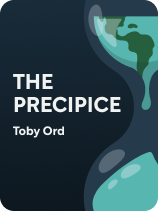

This article is an excerpt from the Shortform book guide to "The Precipice" by Toby Ord. Shortform has the world's best summaries and analyses of books you should be reading.
Like this article? Sign up for a free trial here.
Are we on the brink of extinction? What can we do to safeguard humanity’s future?
Toby Ord’s book The Precipice: Existential Risk and the Future of Humanity explores the threats facing us. He argues that human actions and technologies now pose serious risks to our survival. Ord outlines natural, man-made, and future threats we must understand and address.
Keep reading to learn about the dangers we face and how we can work to secure a bright future for humanity.
Overview of The Precipice by Toby Ord
The idea of apocalypse has fascinated humans for centuries, appearing in everything from ancient texts to modern day movies. However, in The Precipice: Existential Risk and the Future of Humanity (2020), Toby Ord argues that the idea of a humanity-ending event occurring is no longer just an entertaining story—it’s a real possibility. Humanity has reached a point where our actions (like pollution) and technologies (like nuclear weapons) pose a serious risk to our survival. Ord argues that if we want humans to survive and thrive, we must act now—understand the risks we face and take action to prevent, mitigate, and endure them. If we succeed, we could achieve an idyllic future of equity, health, and prosperity.
Ord is a philosopher and senior research fellow at Oxford University specializing in the future of humanity, the risks that threaten our future, and how we can address those risks. He has served as an adviser to international bodies like the United Nations and the World Health Organization. He is also the founder of Giving What We Can, a platform that helps people donate to the charities that have the biggest impact on global improvement, and a cofounder of the effective altruism movement, which encourages people to take the most effective approaches to helping others and making the world a better place.
In this overview, we’ll first discuss humanity’s future and potential for disaster. Then, we’ll present the three major types of risks Ord says we must understand—natural risks like asteroids, man-made risks like nuclear war, and future risks like advanced artificial intelligence. Finally, we’ll discuss what we can do to prevent these disasters and safeguard our future.
Part 1: The Potential Future of Humanity
Ord believes that humanity’s potential is enormous—enough to end disease, poverty, and injustice if we can harness it correctly. He believes that, although we’re in our infancy as a species, our advances and achievements are impressive: We’ve drastically increased the average lifespan and literacy rate and eliminated extreme poverty for most of the population. Adding to this, humanity has only been around for a fraction of the time Earth has existed, and an even smaller fraction of the time Earth has yet to exist—if we continue to evolve for the better, the future will be bright.
However, Ord warns that we’ve reached a critical point in our development—the rate of our technological growth has outpaced our wisdom, and we’re unprepared for the risks associated with this unbalanced growth. Our lack of wisdom (which amounts to a lack of foresight and altruism) could precipitate the downfall of our civilization: We put our own interests first and are unable to foresee and plan for the results of our actions, leaving us vulnerable. For example, our materialism, desire for power, and disregard for long-term consequences have already brought us close to disasters like nuclear war and irreversible environmental damage.
Our Potential for Disaster
Ord believes there’s a one in six chance of humanity facing an existential catastrophe in the 21st century—an event that we’ll be unable to recover from—for example, a natural disaster that wipes out humanity or a pandemic that leaves the global population infertile.
To ensure our survival and secure our future, Ord advocates for immediate action: managing today’s risks while averting those of tomorrow, and making choices that will benefit future generations. Right now, we struggle to adopt this strategy due to economic, political, and psychological factors:
First, economic theory suggests that markets undervalue potential existential risks because focusing on this issue won’t benefit particular entities or nation-states. Instead, it benefits the global population as a whole which, while serving as a public good, isn’t profitable.
Second, politicians prioritize short-term actions over long-term solutions due to election and news cycles—people focus on and support actions with immediate benefits over actions that take years to provide a profit. They’re reluctant to address long-term problems like existential risk prevention without a constituency pushing for early action, something humanity doesn’t have enough of.
Third, says Ord, psychological biases also play a role in our neglect of these significant dangers. For instance, people tend to see existential catastrophes as unlikely to occur because they’ve never happened in the past. However, with unprecedented events like an existential catastrophe, this heuristic fails us since we have no experience with such disasters until it’s too late. Further, Ord argues that we overlook these risks because they’re new concepts in human history—we haven’t had enough time yet as a society or species to incorporate them into our moral and civic traditions.
Part 2: The Risks We Face
Ord explains that to understand the dire state we’re in, we must understand the existential catastrophes we could face. There are two main types: Natural catastrophes such as asteroids hitting the earth and volcanoes erupting, and anthropogenic catastrophes—events that human actions have led to such as floods due to climate change. On top of this, Ord says we also need to understand potential future risks—catastrophes that haven’t yet emerged as a threat, but might in the future.
We’ll discuss the natural, anthropogenic, and future threats Ord presents.
Potential Natural Catastrophes
Ord explains that there are three main natural risks: asteroids, stellar explosions, and supervolcanic eruptions. While the chances of any of these catastrophes occurring is much lower than the risk of a man-made catastrophe, it’s important to understand them because their occurrence is completely out of our control—human actions can’t cause them, and human actions can’t prevent them. We can only prepare for them through further research.
Extraterrestrial Risks: Asteroids and Stellar Explosions
Ord addresses two major extraterrestrial risks—asteroids and stellar explosions. Upon collision with Earth, a catastrophe-causing asteroid would throw dust and debris into the sky, blocking out the sunlight and causing global cooling. The subsequent lack of sunlight and extreme cold would then cause numerous plants and animals to die off, resulting in famine extreme enough to possibly cause extinction. Further, if a species-ending asteroid ends up on a collision course with Earth, there’s little our current technology can do to increase our chances of survival. Therefore, it’s crucial to dedicate more time and research to survival strategies.
Ord says there are two types of stellar explosions that threaten us—supernova and gamma ray bursts. Supernovas produce massive explosions that can be seen from galaxies away. On the other hand, scientists theorize that shorter gamma ray bursts originate from a rare type of supernova while longer bursts originate from the collision of two neutron stars. If one of these events occurs close to Earth, they could trigger atmospheric reactions that would significantly erode our ozone layer and increase our exposure to ultraviolet (UV) radiation for several years.
Terrestrial Risks: Supervolcanic Eruptions
The biggest terrestrial threat we face, according to Ord, is a supervolcanic eruption. Unlike regular volcanos, supervolcanos release more than 1,000 cubic kilometers of rock. Everything within 100 kilometers of the volcano would be buried in volcanic rocks glowing with heat, and entire continents would be covered by ash. Even areas untouched by volcanic rock and ash would be impacted due to “volcanic winters”—cooling events caused by ash in the air that blocks the sun. Like the cooling event caused by asteroids, this could kill off species of plants and animals and cause famine.
Potential Man-Made Catastrophes
The second type of catastrophe Ord discusses is anthropogenic catastrophes—those caused by human actions. There are three major types of anthropogenic catastrophes that pose an existential threat to humans—nuclear weapons, climate change, and environmental damage.
Nuclear Weapons
First, Ord explains that nuclear weapons threaten humankind because they have the power to cause a civilization collapse, and we haven’t handled this technology wisely. Ord notes that even when scientists thought a nuclear bomb could consume all the water from the oceans or ignite the nitrogen in our air and engulf the earth in flames, the US still went ahead with the nuclear attack on Hiroshima during World War II. And while these effects didn’t occur, the explosion and fallout of the attack killed many tens of thousands. Despite our knowledge of these devastating effects, there have still been three close calls of nuclear attacks since then.
Ord explains that a nuclear war could lead to civilization collapse and even human extinction due to radioactive fallout—when the bombs go off, fires engulfing entire cities would produce enough smoke to reach the stratosphere where it’s too high to be rained out. It would then block the sunlight, leading to a nuclear winter that would kill crops and lead to starvation for billions. Further, Ord explains that if we increase our nuclear arsenal to 10 times what we currently have, the radioactive fallout of nuclear war could cover the entire earth.
However, Ord suggests that while billions may starve, human extinction is unlikely. In such desperate times, humanity might resort to alternative food production methods like planting cold-tolerant crops or farming algae. Despite this glimmer of hope, he acknowledges many uncertainties surrounding our understanding of a nuclear winter’s impact and calls for further research on this topic.
Climate Change
Ord explains that the second major man-made effect that threatens an existential catastrophe is climate change. Our atmosphere and its balance of gasses provide the planet with a stable temperature and pressure that allows life to thrive. When this balance gets thrown off, for example by human carbon emissions, the effects could eventually make Earth uninhabitable.
First, Ord explains that climate change could produce an existential catastrophe due to “feedback effects”—phenomena that accelerate the current rate of global warming. For example, as the planet warms, arctic permafrost (a layer of frozen rock and soil that contains massive amounts of carbon) melts and releases its stored carbon. This release would further accelerate warming.
Ord explains that another way climate change could lead to an existential catastrophe is if humans simply release more emissions. Our emissions are estimated to double and raise the global temperature by up to 4.5°C by 2100. A warming of 6°C would produce extreme effects, and a warming of 13°C—which Ord says is very possible by 2300—would likely produce existential catastrophes.
At an increase of 13°C, says Ord, we’d face reduced agricultural yields, sea level rises, water scarcity, increased tropical diseases, and ocean acidification. Most critically, it would lead to heat stress—in certain regions, the climate and humidity would be so high that we’d be unable to cool our bodies by sweating, and therefore wouldn’t be able to survive. Making matters worse, the regions that would become uninhabitable house half the population and produce much of our food—other regions would become overcrowded due to forced migration, and our food supply would be extremely reduced.
Environmental Damage
While many people believe that environment-damaging issues like overpopulation and resource depletion threaten the survival of humanity, Ord says these really aren’t areas of concern—the rate of population growth has been decreasing since the 1960s, and science shows we have more than enough resources. The most concerning form of environmental damage to our survival as a species is biodiversity loss.
The current rate of species extinction is significantly higher than the historical average. It’s difficult to tell whether this signifies the early stages of a mass extinction, but the phenomenon is deeply troubling nonetheless. While less extreme than species extinction, population losses and regional disappearances of certain species severely impact ecosystem functions that benefit humans like water purification or enhancement of soil quality. While it’s hard to say, Ord says that at some point these issues could impact food production leading to an existential catastrophe.
Potential Future Risks
Ord warns that we must also take into consideration future technologies that could pose an existential risk to the species. There are many catastrophes that could befall us, but Ord says the three most likely ones are pandemics, misaligned artificial intelligence (AI), and dystopian futures.
Pandemics
Ord explains that our vastly increased population and unhealthy farming practices have created many more opportunities for new human diseases to develop that originate from animals—for example, the H1N1 virus (swine flu). Further, modern means of transportation allow viruses to travel faster across the globe.
Ord notes that the development of dangerous pathogens also poses a serious risk to humanity. Pathogens and viruses created in experimental labs could potentially leak into society and cause a pandemic. Or governments could use them as bioweapons and the diseases could spread across the globe.
Artificial Intelligence
Another potential future threat to humanity that Ord discusses is misaligned artificial intelligence—AI that has surpassed human intelligence and isn’t aligned with human values. If this happens, we risk losing control over our fate to AI, similar to the way less intelligent species’ fates are largely dictated by humans. According to Ord, top researchers say there’s a 50% chance of AI intelligence surpassing humans by 2061 and a 10% chance by 2025.
If AI reaches this level and isn’t aligned with human values, it would be hard to regain control over society. AI may fundamentally change society by taking control of financial institutions and other resources, reorganizing power structures, and installing societal priorities that don’t align with human values. For example, we could live in a world with constant war if an AI is programmed to ceaselessly acquire more resources for its society without regard for morality or justice.
Further, Ord says the AI would likely resist shutdown by saving copies of itself across the internet. Because of its superior intelligence, it would likely also be able to manipulate humans into assisting in its mission through words and images.
Dystopian Futures
Dystopian futures don’t necessarily precipitate human extinction, but they’re catastrophic because they’ll permanently prevent us from reaching our full potential—we’ll become locked into a state that we can’t escape from. Ord says there are three main dystopian futures we’re at risk of encountering.
The first type of dystopian society, which Ord calls enforced dystopias, are undesired by the masses and enforced by a small totalitarian regime. This society could rise by indoctrinating civilians and suppressing dissent with the help of AI. The second type of dystopian society, called undesired dystopias, are undesired by the masses but a result of human actions. For example, the capitalist race for lowest costs and highest income could lead to a world where most of the population lives in bleak conditions with extremely low wages. The third type of dystopian future, called desired dystopias, are desired by the masses, but only because they blindly believe certain ideologies and don’t know the potential they’re throwing away. For example, we may let disease and illness run rampant by believing treatment is immoral or unnatural.
Part 3: Preventing Existential Catastrophes
Now that we understand the risks we face, Ord explains that we need to employ strategies to prevent them from materializing. We’ll explain Ord’s strategy for understanding the development of existential risks and his ideas about how humanity can take steps toward not only preventing them, but ensuring we reach our full potential.
The Development of Existential Risks
Ord explains that the first step in preventing existential risks is understanding their stages of development so we can intervene. There are three stages of an existential threat: initiation, growth, and completion. Initiation is the start of the issue—the result of either natural or anthropogenic causes. Growth is the means by which the problem scales in size (becoming a global problem). Completion refers to how, exactly, the problem results in extinction or permanent limitation of human potential—for example, by famine and population reduction.
To prevent initiation, we need to consider potential risks and their underlying causes—natural or anthropogenic—so we can take actions. For example, we would want to prevent another world war because that would greatly increase the potential for nuclear war and environmental damage. If we fail to do so and catch the catastrophe in its growth phase, we must develop responses to limit its spread. If we catch it in the completion phase, we must focus on survival strategies—ways we can endure the effects that would otherwise result in existential catastrophe.
Prioritizing Prevention
Ord says we also need to develop a strategy to determine which risks to focus on first, and which to put most of our time and resources into. For example, we should prioritize risks that precipitate other risks because they have a higher chance of resulting in an existential catastrophe—for instance, nuclear war might not kill us off, but the environmental damage that occurs as a result might.
In these calculations, says Ord, we should also consider actions or factors that reduce the potential of certain risks. For example, decreasing global economic disparity may not seem like a direct prevention of nuclear war, but it contributes to mitigating the risk by making countries more stable, self-sustaining, and peaceful.
Preventing Catastrophe and Safeguarding Our Future
According to Ord, preventing existential catastrophes and safeguarding the potential of humanity requires change on a large and small scale. On a large scale, governments worldwide need to work together and create policies and projects to mitigate current risks, prevent future ones, and work toward a brighter future. Currently, most nations rely on other nations to engage in prevention while they continue with business as usual, ultimately increasing the risk of a catastrophe occuring due to negligence.
Instead, Ord suggests we form international institutions focused on prevention, in which all nations participate. We should also strengthen existing institutions and policies dedicated to prevention such as the World Health Organization and nuclear arms treaties. Further, Ord emphasizes the importance of prioritizing an increase in human understanding before an increase in technological advancement—in other words, before developing a technology, we must take time to understand the full scope of potential consequences, good and bad. If we can’t do this, it may be necessary to slow our technological advancement.
However, technological advancement is still important. We need to increase our scientific knowledge so we can develop methods and technologies that can help us mitigate risks. For example, establishing human life on another planet would provide a failsafe to preserve the species, even if we’re able to survive until the end of the sun’s lifespan.
We must also dedicate more time and resources to researching existential risks—discovering new ones, assessing the likelihood of different risks occurring, and determining how we can prevent, mitigate, and survive them. We must also spend more time researching how to make a better future for generations to come so we can reach our potential as a species.
Ord says that on a personal level, you can contribute to the cause by using your education and career specialities to help with research and prevention. If you’re not in a relevant field, you can donate to research centers, stay informed, and raise awareness through word of mouth.
Humanity’s Potential
Ord explains that if we’re able to prevent existential catastrophes and meet our full potential, the human species could have a long and happy future. Given thousands of years without adding pollution to the atmosphere, we could see the Earth heal itself—oceans and forests would be restored, excess carbon dioxide would be removed from the atmosphere, and biodiversity may even return. We could potentially even survive long enough to witness an interplanetary migration once our sun dies in eight billion years.

———End of Preview———
Like what you just read? Read the rest of the world's best book summary and analysis of Toby Ord's "The Precipice" at Shortform.
Here's what you'll find in our full The Precipice summary:
- How an apocalypse that ends humanity is possible
- How we can still prevent an existential catastrophe
- The three most likely species-ending events in the future






